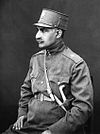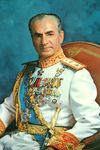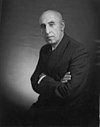Human rights in the Imperial State of Iran
Burglars in particular were subjected to the bastinado (beating the soles of the feet), and the strappado (suspended in the air by means of a rope tied around the victims arms) to "reveal their hidden loot".
Suspected spies and assassins were "beaten, deprived of sleep, and subjected to the qapani" (the binding of arms tightly behind the back) which sometimes caused a joint to crack.
[10] The main form of pressure was solitary confinement and the withholding of "books, newspapers, visitors, food packages, and proper medical care".
[17][18] Following this incident, the Shah went further, banning the chador and ordering all citizens - rich and poor - to bring their wives to public functions without head coverings.
[21] Following the pro-Shah coup d'état that overthrew Prime Minister Mohammad Mosaddegh in 1953, the Shah again cracked down on his opponents, and political freedom waned.
[29] Inspired by international Third World anti-imperialist revolutionaries (such as Mao Zedong, Ho Chi Minh, and Che Guevara, among many others), left-wing guerrillas embraced "armed struggle" to overthrow the Shah, and were quite active in the first half of the 1970s.
[32] According to a senior SAVAK officer, after the Siahkal attack interrogators were sent abroad for scientific training to prevent unwanted deaths from "brute force".`[33] Methods of torture included sleep deprivation; extensive solitary confinement; glaring searchlights; standing in one place for hours on end; nail extractions; snakes (favored for use with women); electrical shocks with cattle prods, often into the rectum; cigarette burns; sitting on hot grills; acid dripped into nostrils; near-drownings; mock executions; and an electric chair with a large metal mask to muffle screams.
He "astounded" the public by coming out in full support of the regime, starting a career working for the government Radio-Television Network" explaining how the Shah was a "true revolutionary".
The 1977 deaths of the popular and influential modernist Islamist leader Ali Shariati and the Ayatollah Ruhollah Khomeini's son Mostafa were believed to be assassinations perpetrated by SAVAK by many Iranians.
[51] A report commissioned (but not published) by the Martyrs Foundation found the total killed in clashes between demonstrators and the Shah's army/security forces during the fourteen months from October 1977 to February 1979 to be not 60,000 but 2781.
[52][49] In reference to the "60,000" figure, the military historian Spencer C. Tucker notes that "Khomeini's regime grossly overstated the revolution's death toll for propaganda purposes".
[46] According to the historian Abbas Amanat:[54] The clerical activists, backed by the Qom marja's, capitalized on the Jaleh Square massacre to paint the regime as brutal and illegitimate.
Aided by a rumor-mongering machine that became fully operational in the absence of reliable media and news reporting, the number of casualties, the “martyrs” on the path of Islam, was inflated to thousands, and the troops who opened fire on them were labeled as Israeli mercenaries who were brought in to crush the revolution.
According to Akbar Ganji, "notions of democracy and human rights have taken root among the Iranian people" making it "much more difficult for the government to commit crimes.
"[62] Writing about the reform period during the presidency of Mohammad Khatami Iranian-American academic Arzoo Osanloo notes that, "liberal notions of rights are almost hegemonic in Iran today.
"[63] And Majd himself explains the Islamic Republic's relative tolerance by claiming that if Iranian intelligence services "were to arrest anyone who speaks ill of the government in private, they simply couldn't build cells fast enough to hold their prisoners.


